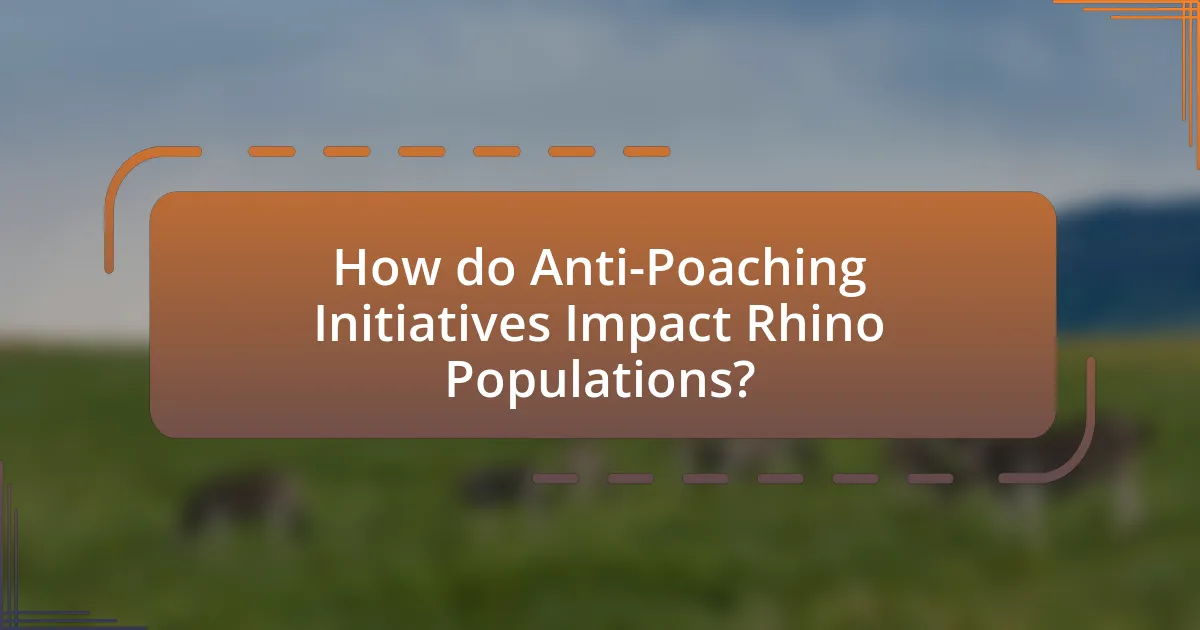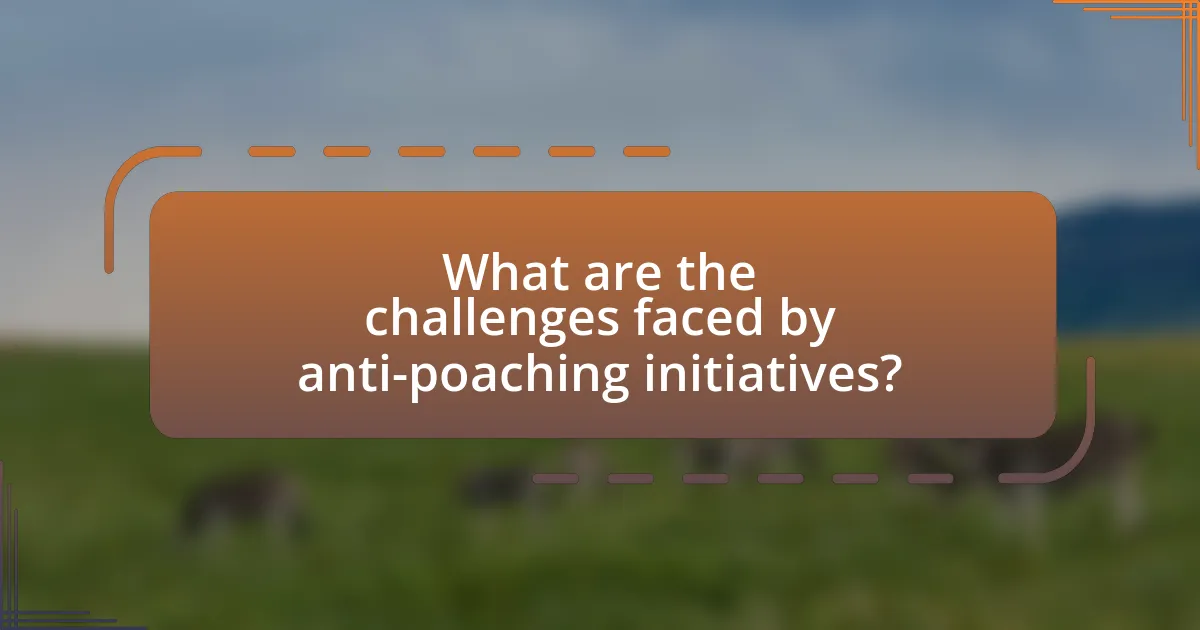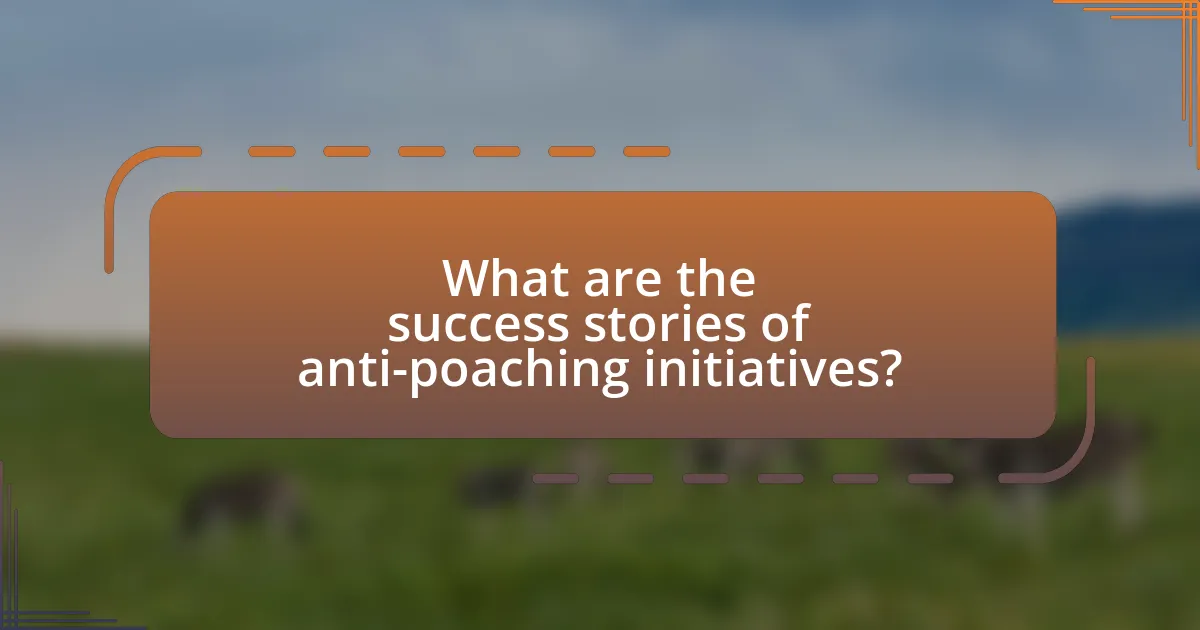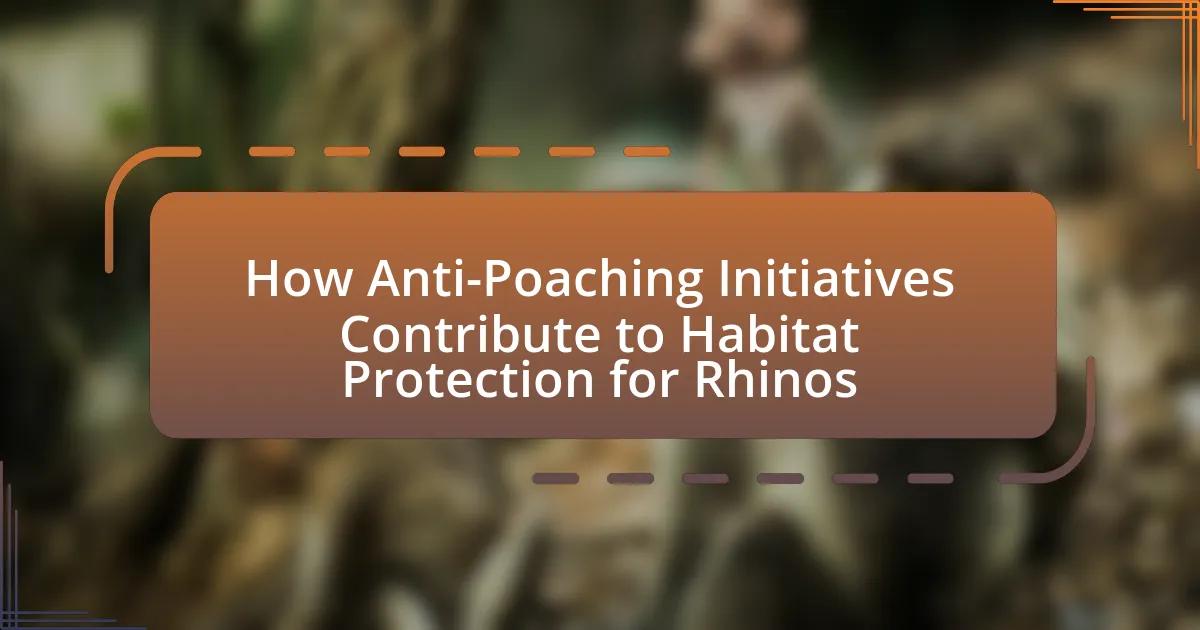Anti-poaching initiatives play a crucial role in enhancing rhino populations by reducing illegal hunting and protecting their habitats. These initiatives employ strategies such as increased surveillance, community engagement, and legal enforcement, which have led to significant declines in poaching incidents and improvements in rhino numbers in regions like South Africa and Namibia. The article explores the primary goals of these initiatives, the importance of habitat protection for rhinos, the challenges faced in implementing these strategies, and the success stories that highlight their effectiveness in conservation efforts. Additionally, it discusses the role of local communities and legal frameworks in supporting anti-poaching measures, providing insights into best practices for future initiatives.

How do Anti-Poaching Initiatives Impact Rhino Populations?
Anti-poaching initiatives significantly enhance rhino populations by reducing illegal hunting and increasing their survival rates. These initiatives, which include increased surveillance, community engagement, and law enforcement, have led to a measurable decline in poaching incidents. For example, in South Africa, the implementation of anti-poaching strategies resulted in a 30% decrease in rhino poaching from 2018 to 2019, contributing to a stabilization of rhino numbers in certain regions. Furthermore, these initiatives often involve habitat protection measures, ensuring that rhinos have safe environments to thrive, which is crucial for their long-term sustainability.
What are the primary goals of anti-poaching initiatives?
The primary goals of anti-poaching initiatives are to reduce illegal wildlife trade, protect endangered species, and preserve biodiversity. These initiatives aim to deter poachers through increased law enforcement, community engagement, and habitat protection measures. For example, according to the World Wildlife Fund, anti-poaching efforts have led to a significant decrease in rhino poaching rates in regions like South Africa, where targeted strategies have resulted in a 50% reduction in poaching incidents over recent years.
How do these goals align with rhino conservation efforts?
The goals of anti-poaching initiatives directly align with rhino conservation efforts by reducing illegal hunting and protecting their habitats. These initiatives aim to strengthen law enforcement, increase surveillance, and engage local communities, which collectively contribute to the preservation of rhino populations. For instance, a study by the World Wildlife Fund reported that regions with robust anti-poaching measures saw a significant decrease in rhino poaching incidents, demonstrating the effectiveness of these strategies in safeguarding rhinos and their ecosystems.
What strategies are employed in these initiatives?
Anti-poaching initiatives employ several key strategies to protect rhinos and their habitats. These strategies include increased surveillance through the use of drones and camera traps, which enhance monitoring of wildlife and deter poachers. Additionally, community engagement programs educate local populations about the ecological importance of rhinos, fostering a sense of stewardship. Law enforcement collaboration is also critical, as it strengthens anti-poaching laws and increases the likelihood of apprehending poachers. Furthermore, habitat restoration efforts are implemented to ensure that rhinos have access to safe and sustainable environments. These strategies are supported by data indicating that regions with robust anti-poaching measures see a significant decline in poaching incidents, thereby contributing to the overall protection of rhino habitats.
Why is habitat protection crucial for rhinos?
Habitat protection is crucial for rhinos because it ensures their survival by providing the necessary resources for feeding, breeding, and shelter. Rhinos depend on specific ecosystems, such as grasslands and forests, which are increasingly threatened by human activities like agriculture and urban development. According to the International Union for Conservation of Nature, habitat loss is one of the primary drivers of rhino population decline, with some species facing extinction if their habitats are not preserved. Effective habitat protection measures, often supported by anti-poaching initiatives, help maintain the ecological balance and safeguard the future of rhinos in the wild.
What role does habitat play in the survival of rhinos?
Habitat is crucial for the survival of rhinos as it provides the necessary resources for their feeding, breeding, and shelter. Rhinos depend on specific types of vegetation and terrain, such as grasslands and forests, which support their dietary needs and offer protection from poachers. For instance, the availability of adequate forage directly influences their health and reproductive success, with studies indicating that habitat loss can lead to population declines. Furthermore, intact habitats facilitate the natural behaviors of rhinos, such as social interactions and territoriality, which are essential for their survival and overall ecosystem balance.
How does habitat degradation affect rhino populations?
Habitat degradation significantly reduces rhino populations by diminishing their natural living environments and food sources. As habitats become fragmented or destroyed due to human activities such as agriculture, urbanization, and deforestation, rhinos face increased competition for resources, leading to lower survival rates. For instance, studies indicate that habitat loss has contributed to a decline of over 90% in certain rhino species, such as the Javan rhino, which now exists in a single population of fewer than 80 individuals. This degradation not only threatens their immediate survival but also disrupts breeding patterns, further endangering their long-term viability.
How do anti-poaching initiatives contribute to habitat protection?
Anti-poaching initiatives contribute to habitat protection by reducing illegal hunting that threatens wildlife populations, which in turn maintains ecosystem balance. When poaching is curtailed, the natural behaviors and populations of species, such as rhinos, can stabilize, allowing vegetation and other wildlife to thrive. For instance, the World Wildlife Fund reports that protected areas with effective anti-poaching measures see a significant increase in biodiversity, as the presence of keystone species like rhinos helps to shape their habitats and promote healthy ecosystems. Thus, by safeguarding these animals, anti-poaching efforts indirectly protect the habitats they inhabit.
What methods are used to protect rhino habitats from poaching?
Anti-poaching initiatives employ several methods to protect rhino habitats from poaching, including increased surveillance, community engagement, and legal enforcement. Increased surveillance involves the use of drones, camera traps, and on-the-ground patrols to monitor rhino populations and detect poachers. Community engagement focuses on involving local populations in conservation efforts, providing them with alternative livelihoods to reduce reliance on poaching. Legal enforcement strengthens anti-poaching laws and penalties, ensuring that poachers face significant consequences for their actions. These methods collectively contribute to the preservation of rhino habitats and the reduction of poaching incidents.
How do these methods enhance the overall ecosystem?
Anti-poaching initiatives enhance the overall ecosystem by preserving biodiversity and maintaining ecological balance. These methods protect not only rhinos but also the myriad of species that share their habitat, ensuring that the ecosystem functions effectively. For instance, healthy rhino populations contribute to vegetation management through grazing, which in turn supports other wildlife and plant species. Studies have shown that areas with strong anti-poaching measures experience increased biodiversity, as evidenced by the 2019 research published in the Journal of Wildlife Management, which found that protected areas had 30% more species diversity compared to unprotected regions. Thus, anti-poaching initiatives play a crucial role in sustaining the health and resilience of ecosystems.

What are the challenges faced by anti-poaching initiatives?
Anti-poaching initiatives face significant challenges, including inadequate funding, corruption, and lack of community support. Inadequate funding limits the resources available for surveillance, training, and equipment necessary for effective anti-poaching operations. Corruption among law enforcement and government officials can undermine efforts, allowing poachers to operate with impunity. Additionally, without the support of local communities, initiatives may struggle to gain intelligence and cooperation, as local populations may not see the benefits of conservation efforts. These challenges hinder the effectiveness of anti-poaching strategies and threaten the survival of rhino populations.
What obstacles hinder the effectiveness of these initiatives?
Obstacles that hinder the effectiveness of anti-poaching initiatives include insufficient funding, lack of community involvement, and inadequate law enforcement. Insufficient funding limits resources for training, equipment, and technology necessary for effective anti-poaching operations. A lack of community involvement can lead to local populations not supporting or participating in conservation efforts, which diminishes the initiatives’ impact. Additionally, inadequate law enforcement results in weak penalties for poachers, failing to deter illegal activities. For instance, a study by the World Wildlife Fund indicates that regions with stronger community engagement and law enforcement see a significant reduction in poaching incidents.
How do funding and resource limitations impact anti-poaching efforts?
Funding and resource limitations severely hinder anti-poaching efforts by reducing the capacity for surveillance, enforcement, and community engagement. Insufficient financial resources lead to fewer rangers on the ground, inadequate training, and limited technological support, which are essential for effective monitoring of wildlife habitats. For instance, a study by the World Wildlife Fund indicated that protected areas with higher funding levels have significantly lower poaching rates, demonstrating a direct correlation between financial investment and successful anti-poaching outcomes. Additionally, resource constraints can limit partnerships with local communities, which are crucial for intelligence gathering and fostering conservation awareness. Thus, without adequate funding and resources, anti-poaching initiatives struggle to maintain their effectiveness, ultimately jeopardizing the protection of endangered species like rhinos.
What role does local community involvement play in overcoming these challenges?
Local community involvement is crucial in overcoming challenges related to anti-poaching initiatives for rhinos. Engaging local communities fosters a sense of ownership and responsibility towards wildlife conservation, which can lead to reduced poaching activities. For instance, programs that educate communities about the ecological and economic benefits of rhinos, such as eco-tourism, have shown to decrease poaching rates significantly. A study by the World Wildlife Fund indicated that areas with strong community engagement saw a 50% reduction in poaching incidents over five years. This demonstrates that when communities are actively involved, they can effectively contribute to habitat protection and the overall success of anti-poaching efforts.
How do legal frameworks support anti-poaching initiatives?
Legal frameworks support anti-poaching initiatives by establishing laws and regulations that criminalize poaching and provide penalties for offenders. These legal structures enable law enforcement agencies to take action against poachers, facilitating the prosecution of individuals involved in illegal wildlife trade. For instance, the Convention on International Trade in Endangered Species of Wild Fauna and Flora (CITES) provides an international legal framework that regulates trade in endangered species, including rhinos, thereby reducing poaching incentives. Additionally, national laws, such as the Endangered Species Act in the United States, empower authorities to protect threatened species and their habitats, further reinforcing anti-poaching efforts.
What laws are in place to protect rhinos and their habitats?
Laws protecting rhinos and their habitats include the Convention on International Trade in Endangered Species of Wild Fauna and Flora (CITES), which regulates international trade of rhino products, and national laws such as the Endangered Species Act in the United States, which provides legal protection for endangered species, including rhinos. Additionally, many countries have established specific wildlife protection laws that prohibit poaching and habitat destruction, such as South Africa’s National Environmental Management: Biodiversity Act, which aims to conserve biodiversity and protect endangered species. These laws are enforced through various measures, including anti-poaching patrols and habitat conservation programs, which are essential for the survival of rhinos in the wild.
How effective are these laws in deterring poaching activities?
Anti-poaching laws are moderately effective in deterring poaching activities, as evidenced by a reduction in rhino poaching rates in regions with stringent enforcement. For instance, South Africa reported a 33% decrease in rhino poaching incidents from 2018 to 2019 due to enhanced legal frameworks and increased penalties for offenders. Furthermore, the implementation of community-based conservation programs has shown that local engagement and education can complement legal measures, leading to a more significant impact on reducing poaching. These statistics indicate that while laws alone may not completely eliminate poaching, they play a crucial role in creating a deterrent effect when combined with community involvement and enforcement efforts.

What are the success stories of anti-poaching initiatives?
Anti-poaching initiatives have seen significant success in reducing illegal wildlife trade and protecting rhino populations. For instance, in South Africa, the implementation of the “Integrated Strategic Management of Rhinoceros” plan led to a 33% decrease in rhino poaching from 2014 to 2015, showcasing effective law enforcement and community engagement strategies. Additionally, the establishment of the Black Rhino Range Expansion Project has successfully increased the black rhino population from 1,800 in 1995 to over 5,600 in 2021, demonstrating the positive impact of habitat protection and anti-poaching efforts. These initiatives highlight the effectiveness of coordinated conservation strategies in safeguarding rhinos and their habitats.
Which regions have seen significant improvements in rhino populations?
Significant improvements in rhino populations have been observed primarily in South Africa, Namibia, and India. In South Africa, the implementation of anti-poaching initiatives and conservation efforts has led to a notable increase in the white rhino population, which rose from approximately 18,000 in 1990 to over 18,000 in recent years. Namibia has also seen success with its black rhino population, which increased from around 2,400 in 1995 to over 5,000 due to community-based conservation programs. In India, the population of the Indian rhino has grown from about 600 in the 1970s to over 3,000 today, largely due to effective protection measures in Kaziranga National Park. These statistics demonstrate the positive impact of targeted conservation strategies in these regions.
What specific anti-poaching strategies contributed to these successes?
Specific anti-poaching strategies that contributed to successes include enhanced surveillance, community engagement, and legal enforcement. Enhanced surveillance, such as the use of drones and camera traps, has significantly improved monitoring of rhino populations and their habitats, leading to a reduction in poaching incidents. Community engagement initiatives, which involve local populations in conservation efforts, have fostered a sense of ownership and responsibility towards wildlife, resulting in increased reporting of poaching activities. Legal enforcement, including stricter penalties for poachers and increased ranger patrols, has deterred illegal hunting and protected rhino habitats effectively. These strategies have collectively led to measurable declines in rhino poaching rates in various regions, demonstrating their effectiveness in habitat protection.
How have these successes influenced global conservation efforts?
Successes in anti-poaching initiatives have significantly influenced global conservation efforts by demonstrating effective strategies for wildlife protection. For instance, countries like South Africa have reported a decrease in rhino poaching rates due to enhanced law enforcement and community engagement, which serve as models for other nations facing similar challenges. The International Union for Conservation of Nature (IUCN) noted that these successes have led to increased funding and support for conservation programs worldwide, as evidenced by a 30% rise in international donations to wildlife protection initiatives from 2015 to 2020. This shift in focus has encouraged collaborative efforts among governments, NGOs, and local communities, fostering a more unified approach to biodiversity conservation on a global scale.
What lessons can be learned from successful anti-poaching initiatives?
Successful anti-poaching initiatives demonstrate the importance of community involvement and education in conservation efforts. Engaging local communities fosters a sense of ownership and responsibility towards wildlife, which has been shown to reduce poaching rates significantly. For instance, the African Wildlife Foundation reported that in areas where community-based programs were implemented, poaching decreased by up to 50%. Additionally, effective law enforcement and intelligence-sharing among agencies are crucial, as evidenced by the success of the Kruger National Park’s anti-poaching strategies, which led to a 70% reduction in rhino poaching incidents over a five-year period. These initiatives highlight that a multifaceted approach, combining community engagement, law enforcement, and education, is essential for sustainable wildlife protection.
How can these lessons be applied to other conservation efforts?
The lessons learned from anti-poaching initiatives can be applied to other conservation efforts by emphasizing community involvement, effective law enforcement, and habitat management. Community engagement fosters local stewardship, as seen in successful rhino conservation programs where local populations participate in monitoring and protecting wildlife, leading to a 50% reduction in poaching incidents in some regions. Effective law enforcement, demonstrated through increased ranger patrols and intelligence sharing, can be replicated in other conservation areas to deter illegal activities. Additionally, habitat management practices, such as restoring native vegetation and creating wildlife corridors, can enhance ecosystem resilience, as evidenced by the positive outcomes in areas where these strategies have been implemented.
What best practices should be adopted for future initiatives?
Future anti-poaching initiatives should adopt a multi-faceted approach that includes community engagement, advanced technology, and continuous monitoring. Engaging local communities fosters collaboration and ensures that residents benefit from conservation efforts, as evidenced by programs in Kenya where community-led initiatives have reduced poaching rates by up to 80%. Utilizing advanced technologies such as drones and GPS tracking enhances surveillance and response capabilities, which has been shown to improve the effectiveness of anti-poaching operations significantly. Continuous monitoring through data collection and analysis allows for adaptive management strategies, ensuring that initiatives remain effective in changing environments. These best practices are supported by successful case studies, such as the Black Rhino Range Expansion Project, which demonstrates the importance of integrating community involvement and technology in conservation efforts.
What practical steps can individuals take to support anti-poaching initiatives?
Individuals can support anti-poaching initiatives by donating to reputable wildlife conservation organizations that focus on anti-poaching efforts. These organizations, such as the World Wildlife Fund and the African Wildlife Foundation, utilize funds to implement patrols, surveillance, and community education programs that directly combat poaching. Additionally, individuals can participate in or organize awareness campaigns to educate others about the importance of wildlife conservation and the impact of poaching on ecosystems, particularly for endangered species like rhinos. Engaging in responsible tourism, which includes visiting wildlife reserves that prioritize anti-poaching measures, also contributes to funding and supporting local conservation efforts. According to a report by the International Union for Conservation of Nature, community involvement and financial support are critical in reducing poaching rates and enhancing habitat protection for species at risk.
